The Wasp
The wasp (Vespula sp.) is sometimes confused with the bee. The wasp is much more aggressive than the bee. It stings to defend the territory around its nest. It’s distinguished by its very thin size, its body with black and yellow stripes, and the absence of hair. It also has two antennae and—in the female only—a stinger. The wasp is about 10 to 20 mm long. You can detect the wasps present in your environment by noticing their nest in a tree or underground.
The lifestyle of the wasp
Habitat
Wasps live in swarms. The individuals of this species build a balloon- or umbrella-shaped nest in a tree or an underground nest in an abandoned rodent tunnel. The nest is usually sheltered from the wind and rain. It will contain a queen, workers, and males. Wasps are active from the spring to the fall but die with the arrival of the cold.
Diet
The wasp feeds on sugar (fruit juice, soft drinks, etc.), decomposing fruit, and sometimes honey from hives. The larvae feed on insects hunted by the adults and cut into small pieces.
Reproduction
The risks associated with wasps

The risks associated with wasps
Besides being very painful, wasp stings can be very dangerous if they are numerous or in case of allergies. Wasps are very aggressive in order to protect their environment and attack individuals who penetrate their territory. You should be careful and contact a wasp control pro since they occupy a large area. If the nest is attacked or broken, the wasps will emerge in large numbers to defend it. It’s therefore strongly discouraged to try to get rid of a wasp nest yourself. A qualified wasp control technician from ExterminaPro can come to your home with specialized equipment to remove the nest without any risk of stinging or danger to your family.

